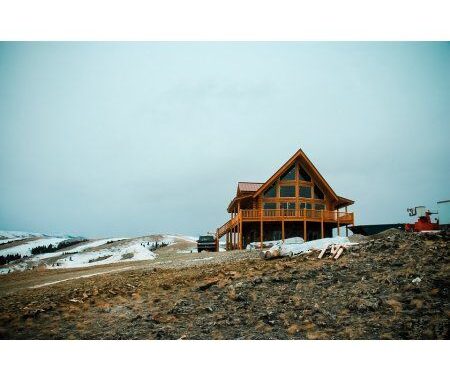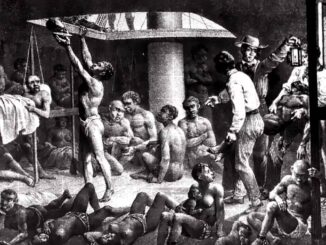
Various artifacts, stories and a 12 minute film trace America’s struggle from the earliest beginnings of slavery through the Civil War unto reconstruction after the attainment of freedom at the Underground Railroad Freedom Center.
One of the most memorable exhibits is the wooden log cabin preserved and restored within the center to represent a principal instrument of dehumanizing the black race with more than 75 slaves usually stacked on the limited floor space and above in special racks to which they were shackled and chained thus forced to eat and defecate right there.
This structure was an actual one found on a Kentucky farm in Mason County which was moved from there and rebuilt in the Freedom Center. It now dominates the second-floor atrium where visitors encounter it again and again while traversing the other exhibits. It could also be seen through the Center’s large windows from the downtown street outside.
Slaves were temporarily housed there on their way south to be resold.This 21 by 30 foot (6 by 9m), two-story log slave pen built in 1830 was used to house slaves being shipped to be auctioned.
An original feature of the Slave Pen is a shackle ring in the second floor joist, which was being used to secure male slaves.
The pen is said to have been originally owned by Captain John Anderson, a Revolutionary War soldier who became a slave trader. He was particularly known for his keen business sense watching time.and other conditions that could enhance or ruin his chances for a good profit. He would always appraise the potential market, his investments and deal-making and the intricacies of gathering, holding, transporting and selling slaves at the slave markets in Natchez, Mississippi before making a plunge.
Slaves waiting to be transported from Dover, Kentucky to slave markets in Natchez, Mississippi and New Orleans, Louisiana were imprisoned in this barn for a few days or several months, waiting for favorable market conditions and higher selling prices to prevail.
The barn has eight small windows, the original stone floor from a large chimney and a fireplace. There is a row of wrought iron rings through which a central chain ran, tethering men on either side of the chain. Male slaves were held on the second floor, while women remained on the first floor where they used the fireplace for cooking.
“The pen is powerful,” Carl B. Westmoreland, curator and senior adviser to the museum said. “It has the feeling of hallowed ground. When people stand inside, they speak in whispers. It is a sacred place. I believe it is here to tell a story – the story of the internal slave trade to future generations.” Visitors to the museum walk through the holding pen and touch its walls, as we did when 17 of us from different parts of the world visited it.. Taken from records kept by slave traders in the area who used the pen, the first names of some of the slaves believed to have been held in the pen are listed on a wooden slab in the pen’s interior.
Westmoreland spent three and a half years uncovering the story of the slave jail. “We’re just beginning to remember. There is a hidden history right below the surface, part of the unspoken vocabulary of the American historic landscape. It’s nothing but a pile of logs, yet it is everything.”
Other prominent features of the Center include:
o The “Suite for Freedom” Theater where three animated films address the fragile nature of freedom throughout human history, particularly as related to the Underground Railroad and the institution of slavery in the United States.
o The “ESCAPE! Freedom Seekers” presentation and interactive display about the Underground Railroad where school groups and families with young children are presented with choices on an imaginary escape attempt. The gallery features information about figures like abolitionist William Lloyd Garrison, Underground Railroad conductor Harriet Tubman. and orator Frederick Douglass ~Escape Freedom Seekers and ~The Underground Railroad is an intriguing and inviting hands-on interactive experience designed particularly for children and families encouraging them to explore this troubled period of American history. The center is almost transformed to a school as stories of people and families involved in fighting against slavery are being told.
o The film, “Brothers of the Borderland,” highlighting the story of the Underground Railroad in Ripley, Ohio along the Ohio River and the roles of conductors John Parker and Reverend John Rankin.
o Information about the history of slavery and those who opposed it, including John Brown, Abraham Lincoln and the American Civil War.
o “The Struggle Continues,” an exhibit depicting the ongoing challenges confronted by African-Americans since the end of slavery, ongoing struggles for freedom in today’s world, and ways that the Underground Railroad has inspired groups in India, Poland and South Africa.
o The John Parker Library which houses a collection of multimedia materials about the Underground Railroad and freedom-related issues.
o The FamilySearch Center where visitors can investigate their own roots.
The Freedom Center’s Executive Director and CEO, Spencer Crew, was previously the director of the Smithsonian Institution’s National Museum of American History.
Related Article:
http://ezinearticles.com/?Introduction-to-Underground-Railroad-Freedom-Center&id=864485
Unless otherwise stated, PONIREVO and/or its licensors DO NOT own any intellectual property rights in the website and material on the website. Majority of the site’s content has been scraped and auto posted by a third party artificial intelligence program —– PONIREVO Creation Team.
Proudly WWW.PONIREVO.COM
by Arthur Smith



